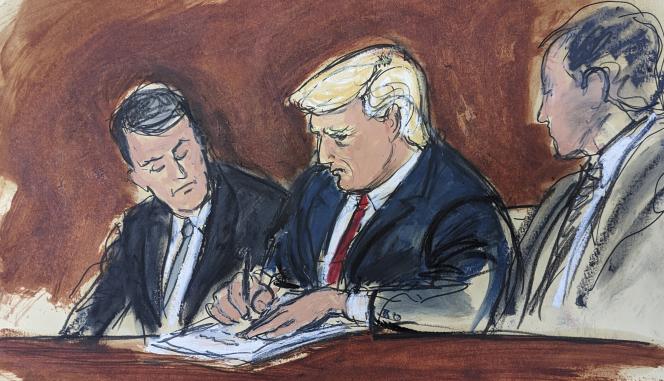The audience was historic. Accused of having put the security of the United States at risk by keeping confidential documents after his departure from the White House, Donald Trump was called to appear on Tuesday, June 13, before the federal court in Miami. All the press was obviously mobilized but, in the race for information on the judicial and political future of the former president – who will seek a new mandate in 2024 -, a major obstacle stood up: no communication was possible. between the courtroom and the outside, the judge having prohibited the public as well as reporters from entering it with the slightest electronic device, cameras, computers and telephones included.
How did CNN manage to reveal before all its competitors that the 45e President of the United States had pleaded not guilty to the thirty-seven charges brought against him? the stratagem, that the channel unveiled on Wednesdayis just as incredible as it is anachronistic, in a country where (almost) nothing escapes the cameras or the demand for transparency of taxpayers (taxpayers) with respect to their institutions.
It all started on Monday, the day before the hearing, with the dispatch of a reconnaissance mission. Responsible for inspecting the Miami courthouse, the CNN team spotted two public telephone sets there, forgotten relics of the wired past of telecoms (the last cabins in New York were dismantled in 2022), but the only way to communicate quickly with the outside. Noah Gray, Senior Channel Coordinator for special events (special events), can then develop their plan.
Transparency and impartiality
It turns out that he himself grew up in Miami, where he attended Palmetto Senior High School, and contacts a professor of broadcast journalism to offer to temporarily hire some of his students. The case is, it seems, very quickly heard. The next day, the courtroom is packed. Alongside Hannah Rabinowitz and Tierney Sneed, the two CNN reporters armed only with their notepads, are a handful of teenagers. When Todd Blanche, Donald Trump’s lawyer announces: “We resolutely plead ‘not guilty'”, the journalists tear off the pages where they have just scribbled these words and give them to the students, who rush to find their comrade responsible for mounting guard in front of one of the booths. He only has to call to announce the information, but there is a catch: the booths only allow local calls.
However, the problem was anticipated. Another team is stationed in a van that serves as the chain’s mobile headquarters. On board is a local production assistant, whose mobile phone number is accessible. It is he who relays with Brad Parks, regional director of the investigation antenna, who can in turn transmit the information to the Washington office, where it is validated and then announced on the antenna, before all the others. Networks. “In all my years in the field, I have never been involved in such a complex telephone operation”said Noah Gray, at the end of the hearing.
Beyond its inventiveness, the operation fueled the debate on the transparency of federal justice often considered archaic and braced on its principles. In the one concerning Donald Trump, the sketches of the forensic designers will be the only visual pieces to be added to the archives of this historic indictment.
Many legal experts have since deemed it necessary to reform the rules in the name of transparency and impartiality. “I think it’s about the justice of the people, that it’s our taxpayers’ money that pays for it, and that all Americans should be able to see it”, notably estimated Neal Katyal, former acting attorney general, on MSNBC. His arguments seem all the more well-founded since, whatever the prohibitions, the press always ends up circumventing them, as Tuesday’s hearing showed.
In France, except in exceptional cases, cameras are still prohibited, but journalists have the possibility of transmitting their information using telephones or computers. In the United States, television channels are, on the contrary, so omnipresent in the courts, especially since the trial of O. J. Simpso, in 1994, that the absence of an image can almost seem suspect.
“Hyperpolarization”
“Since the 1980s, many trials, including in the preliminary appearance phase, such as the one that took place on Tuesday, have been televised and Americans have become accustomed to it, recalls Marie-Christine Bonzom, political scientist, journalist and specialist in the United States, where she worked for nearly thirty years (1989-2018). This time, the judge did not want the hearing to turn into a media circus. I believe that this power should be left to him.she believes.
The World App
The Morning of the World
Every morning, find our selection of 20 articles not to be missed
Download the app
The press can always assert the right to inform to ask to cover the trials, but in politically sensitive cases, moreover when they relate to confidential documents, the publicity of the proceedings would, according to the expert, only ‘feed “hyperpolarization” of American society. “The United States has reached such a degree of partisan division that it contaminates all spheres of public life, including the judiciary and the media. Today, everyone must ask themselves questions, both the media and the justice system and the two parties that dominate political life.she concludes.
“Proponents of media coverage of the debates believe that viewers must see everything in the name of transparency, but the question is what the public has lost”observes, for her part, Anne Deysine, jurist and professor emeritus at the University of Paris Ouest-Nanterres, who notably published America and Democracy (The Harmattan, 2019). “This time, all that was missing was Donald Trump’s silence and his conspicuously sulky look. The journalists were in the room and the slightest breach would have been reported, including in the absence of images. Conversely, the presence of the cameras would have run the risk that everything would be “sensationalized” and that the lawyers would overplay their score for the media, which would only have accentuated the polarization”she also concludes.
